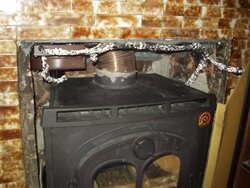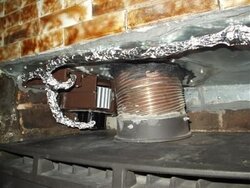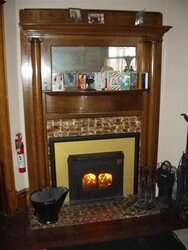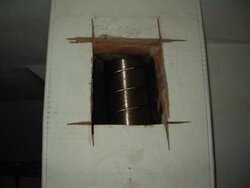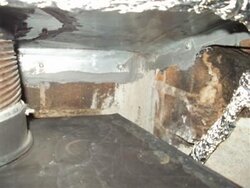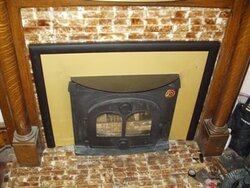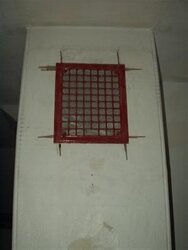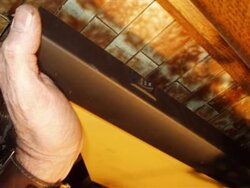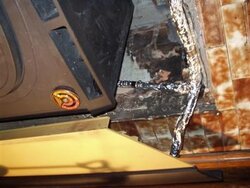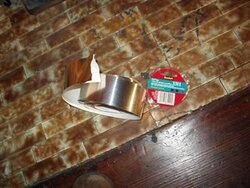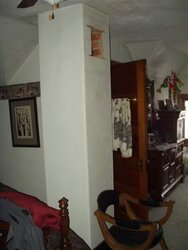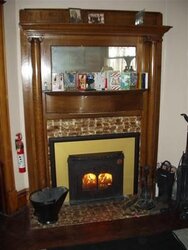Why doesn't anyone mention that the stainless steel liners are the perfect heat exchanger???
I wish someone had told me this before. I can't believe the difference in the heat it gives.
I found a great installation arrangement:
I had first installed my Morso fireplace insert (it was the best fit for my small fireplace dimentions) and found that when I followed the manufacturer's instructions which state to stuff the areas around the stove (sides, back, top) with fiberglass insulation, the chimney mass was hot but the room was cold and the insert would overfire when really loaded.
I tried several arrangements to increase the heat output, like taking out the insulation. I just couldn't get the room to really heat nicely. I even tried temporarilly installing the outlet for the vacuum to the bottom inlet of the insert's heat exchanger, just where many insert manufacturers install an optional fan, but that'd didn't make a real difference either.
The thermostat on the wall in the other room woudn't even rise, but instead fall with the furnace heat off.
It then hit me that I had to get the heat out of the chimney and that the stainless steel liner was much the same material and design as my natural gas furnace is made of.
I cut a square hole in the interior chimney wall high but not at the top of the ceiling, using a circular saw with a fiber mason cutting disc and chisel and hammer in the second floor above the insert which is on the first floor. I stuffed fiberglass insulation above the cut and then installed a vent grill in the hole.
I need the heat to go to the first floor where the larger rooms are, but before I got to the next step of installing a fan to draw the heated air down and out the chimney above the insert, the heated air would naturally rise out into the bedroom from the vent I had installed.
The bedroom was 90 degrees one nite in the middle of a cold night!
I then installed a sheet metal block off plate over the insert in the fireplace and installed a stove approved fan with an automatic on temp 100 degree and above sensor to a round hole I cut in the sheet metal block off plate. I caulked with fireplace silica.
Even though this insert manufacturer doesn't offer a fan, their aluminum surround already had a factory hole on the side for a switch where I installed the on/off/auto switch for the fan.
My old ornate wood mantel top is close to the insert so I installed an upper heat shield over the insert to the bottom of the surround to reduce the heat and any flames that may come out while loading the stove, my old mantal is subjected to.
(I made it from a 1/8 " thick x 6" flat aluminum I bought on E-bay and spray painted with stove paint after I cut it with a jig saw to a nice shape to match the mantel) I also installed a heat shield to the underside of the mantel from left over cutting of the lower heat shield.
To allow heat to come out the chimney just above the insert, I used extra long bolts and two nuts each for the attachment of the upper heat shield to the surround (I had to drill holes in the surround for the bolts) so that the surround would sit about an inch over the insert instead of on it leaving a gap for the blower to force out chimney air.
I installed an outlet in the fireplace for the fan. I wrapped the fan cord wiring with strips of fiberglass insulation and then electric tape and then with aluminum tape (from auto zone heat rated to 300 degrees).
The fan now draws air from the bedroom down the chimney and out just over the insert at up to 220 degrees.
Then that air mixes with the super heated air coming out of the insert's top heat exchanger and really kicks it out some hot air.
It seems the insert now generates as much as 3 times the heat compared to without the hole in the chimey arrangement and the thermostat on the wall in the other room proves it, it goes up.
The gap between the insert top and the bottom of the surround is really not noticable, looks perfessional, not odd at all.
I have several CO sensors in both floors of the house and they never have gone off. This installation is more like a stove now where many times the vent pipe travels across an open ceiling on it's way to the exterior of the house, allowing the vent pipe to exchange heat with the room.
It's been two months now and I feel this is a very safe installation. It seems the insert manufacturers aren't thinking out of the box "fireplace" box in the installation design.
I've attached photos.
I wish someone had told me this before. I can't believe the difference in the heat it gives.
I found a great installation arrangement:
I had first installed my Morso fireplace insert (it was the best fit for my small fireplace dimentions) and found that when I followed the manufacturer's instructions which state to stuff the areas around the stove (sides, back, top) with fiberglass insulation, the chimney mass was hot but the room was cold and the insert would overfire when really loaded.
I tried several arrangements to increase the heat output, like taking out the insulation. I just couldn't get the room to really heat nicely. I even tried temporarilly installing the outlet for the vacuum to the bottom inlet of the insert's heat exchanger, just where many insert manufacturers install an optional fan, but that'd didn't make a real difference either.
The thermostat on the wall in the other room woudn't even rise, but instead fall with the furnace heat off.
It then hit me that I had to get the heat out of the chimney and that the stainless steel liner was much the same material and design as my natural gas furnace is made of.
I cut a square hole in the interior chimney wall high but not at the top of the ceiling, using a circular saw with a fiber mason cutting disc and chisel and hammer in the second floor above the insert which is on the first floor. I stuffed fiberglass insulation above the cut and then installed a vent grill in the hole.
I need the heat to go to the first floor where the larger rooms are, but before I got to the next step of installing a fan to draw the heated air down and out the chimney above the insert, the heated air would naturally rise out into the bedroom from the vent I had installed.
The bedroom was 90 degrees one nite in the middle of a cold night!
I then installed a sheet metal block off plate over the insert in the fireplace and installed a stove approved fan with an automatic on temp 100 degree and above sensor to a round hole I cut in the sheet metal block off plate. I caulked with fireplace silica.
Even though this insert manufacturer doesn't offer a fan, their aluminum surround already had a factory hole on the side for a switch where I installed the on/off/auto switch for the fan.
My old ornate wood mantel top is close to the insert so I installed an upper heat shield over the insert to the bottom of the surround to reduce the heat and any flames that may come out while loading the stove, my old mantal is subjected to.
(I made it from a 1/8 " thick x 6" flat aluminum I bought on E-bay and spray painted with stove paint after I cut it with a jig saw to a nice shape to match the mantel) I also installed a heat shield to the underside of the mantel from left over cutting of the lower heat shield.
To allow heat to come out the chimney just above the insert, I used extra long bolts and two nuts each for the attachment of the upper heat shield to the surround (I had to drill holes in the surround for the bolts) so that the surround would sit about an inch over the insert instead of on it leaving a gap for the blower to force out chimney air.
I installed an outlet in the fireplace for the fan. I wrapped the fan cord wiring with strips of fiberglass insulation and then electric tape and then with aluminum tape (from auto zone heat rated to 300 degrees).
The fan now draws air from the bedroom down the chimney and out just over the insert at up to 220 degrees.
Then that air mixes with the super heated air coming out of the insert's top heat exchanger and really kicks it out some hot air.
It seems the insert now generates as much as 3 times the heat compared to without the hole in the chimey arrangement and the thermostat on the wall in the other room proves it, it goes up.
The gap between the insert top and the bottom of the surround is really not noticable, looks perfessional, not odd at all.
I have several CO sensors in both floors of the house and they never have gone off. This installation is more like a stove now where many times the vent pipe travels across an open ceiling on it's way to the exterior of the house, allowing the vent pipe to exchange heat with the room.
It's been two months now and I feel this is a very safe installation. It seems the insert manufacturers aren't thinking out of the box "fireplace" box in the installation design.
I've attached photos.


